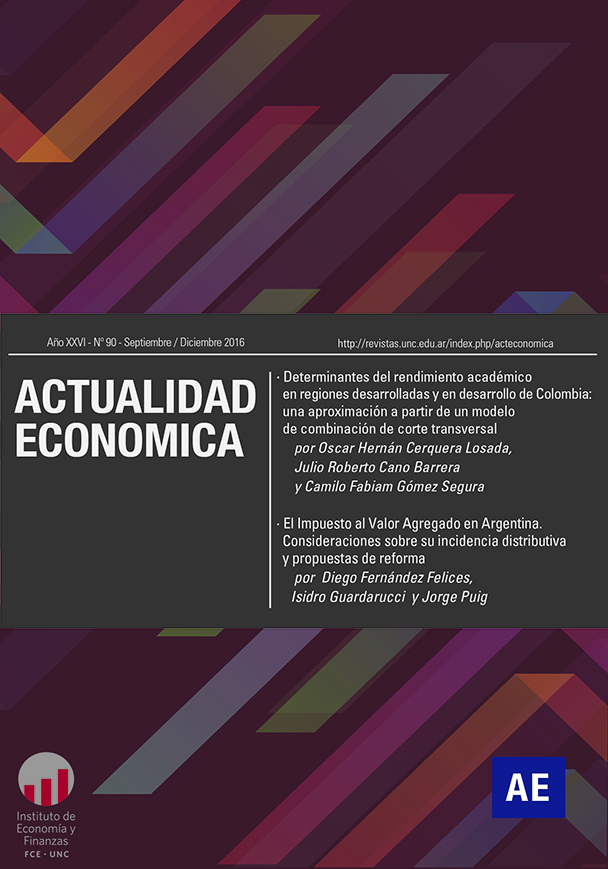Determinants of academic performance in developed and developing regions of Colombia: an approach based on a cross-sectional combination model
Keywords:
Academic performance, test Saber 11, combined model cutaway, regions with higher levels of socioeconomic de-velopment, regions of lower socioeconomic developmentAbstract
In this study the determinants of academic performance is analyzed by comparing the results of the mathematical knowledge test Saber 11 of eleventh grade students of the regions with higher and lower levels of socioeconomic development in Colombia. The main objective of this research is to determine the factors influencing academic performance of secondary education, comparing regions under development and economic growth regions more favorable socioeconomic contexts. The methodology was developed through the application of a combined model cutaway which allows the individual to analyze combinations of units of study temporal, cross-sectional units for the study period 2008-2013. The results show that there are significant differences between the determinants of academic performance in regions with higher and lower levels of socioeconomic development. The personal characteristics of students, such as age and ethnicity, as well as school characteristics have a greater impact on students of regions of lower development; meanwhile, other determinants related to family and household characteristics such as parental education, technological accessibility and household incomes, have a greater impact on the academic performance of students in regions with higher levels of socioeconomic development.
Downloads
References
Vegas, E., y Petrow, J. (2008). Incrementar el aprendizaje estudiantil en América Latina (Primera edición ed.). (M. T. Barajas S., Ed., e I. Caviedes Hoyos, Trad.) Washington, Estados Unidos: Banco Mundial.
Gaviria, A., y Barrientos, J. H. (2001). “Determinantes de la calidad de la educación en Colombia”. Documentos de Economía Departamento Nacional de Planeación (159).
Angrist, J. D., y Krueger, A. B. (1991). “Does compulsory schooling attendance affect schooling and earnings?” Quarterly Journal of Economics, 4 (106), 979-1014.
Barrientos, J. H. (2008). “Calidad de la educación pública y logro académico en Medellín 2004-2006. Una aproximación por regresión intercuartil”. Lecturas de Economía , 121-144.
Caro, B. L. (2000). “Factores asociados al logro académico de los alumnos de 3° y 5° de primaria de Bogotá”. Coyuntura Social - Fedesarrollo (22), 65-80.
Cerquera Losada, O. H. (2011). “Determinantes de la Calidad de la Educación en Neiva”. Programa Jovenes Investigadores , 192.
Chica Gómez, S. M., Galvis Gutiérrez, D. M., y Ramírez Hassan, A. (2010). “Determinantes del Rendimiento Académico en Colombia”. Revista Universidad EAFIT, 46 (160), 48-72.
Coleman, J. S. (1966). Equality of educational opportunity (Primera edición ed.). Washington, Estados Unidos: US Government Printing Office.
Cox, D., y Jiménez, E. (1991). “The Relative Effectiveness of Private and Public Schools: Evidence from Two Developing Countries”. The Journal of Development Economics (34), 99-121.
Darling-Hammond, L. (2000). “Teacher quality and student achievement: a review of state policy evidence”. Center for the Study of Teaching and Policy (Document R-99-1), 48.
Eskeland, G. S., y Filmer, D. (2002). “Autonomy, participation, and learning in Argentine schools: Findings, and Their Implications for Decentralization. World Bank, documento de trabajo 2766, 33.
Fuchs, T., y Woessmann, L. (2005). “What accounts for international differences in student performance? are-examinationusing PISA data”. Empirical Economics, 2 (32), 433-464.
Gaviria, A., y Barrientos, J. H. (2001). “Determinantes de la calidad de la educación en Colombia”. Documentos de Economía Departamento Nacional de Planeación (159).
Hanushek, E. A. (1986). “The economics of Schooling”. Journal of Economic Literature, vol. 24, núm. 3 , 1141-1171.
Hepp K., P., Hinostroza S., E., Laval M., E., y Rehbein F., L. (2004). “Technology in schools: education, ICT, and the knowledge society”. World Bank , 94.
Kerlinger, F. (1983). Investigación del comportamiento. Técnicas y metodología (2° edición). México. Editorial Interamericana.
King, E., y Özler, B. (2000). “What’s decentralization got to do with learning? endogenous school quality and student performance in Nicaragua”. World Bank , 58.
López, S. F. (2010). “El efecto colegio en Colombia: tres décadas de estudio”. Equidad y Desarrollo, 14, 85-101.
Mina Calvo, A. (2004). “Factores asociados al logro educativo a nivel Municipal”. Documento CEDE (15), 38.
Piñeros, L. J., y Rodríguez, A. (1999). “Los insumos escolares en la educación secundaria y su efecto sobre el rendimiento académico de los estudiantes: un estudio en Colombia”. LCSHD Paper Series, 36, 60.
Sanders, W. L., y Rivers, J. C. (1996). “Cumulative and residual effects of teachers on future student academic achievement.” Research Progress Report , 8.
Vegas, E., y Petrow, J. (2008). Incrementar el aprendizaje estudiantil en América Latina (Primera edición ed.). (M. T. Barajas S., Ed., & I. Caviedes Hoyos, Trad.) Washington, DC, Estados Unidos: Banco Mundial.
Wolff, L., Navarro, J. C., y González, P. (2005). “Private education and public policy in Latin America”.Washington: Partnership for Educational Revitalization in the Americas.
Downloads
Published
Issue
Section
License
Those authors who have published with this journal, accept the following terms:
Authors will conserve their copyright and guarantee the magazine the right of first publication of their work, which will be simultaneously subject to the Creative Commons Attribution-NonCommercial-NoDerivative 4.0 International License that allows third parties to share the work as long as the author and first publication of this magazine are indicated.
Authors may adopt other non-exclusive license agreements to distribute the published version of the work (e.g., deposit it in an institutional telematic archive or publish it in a monographic volume) provided that the initial publication in this journal is indicated.
Authors are allowed and encouraged to disseminate their work through the Internet (e.g., in institutional telematic archives or on their website) before and during the submission process, which may lead to interesting exchanges and increase citations of the published work. (See The effect of open access)









